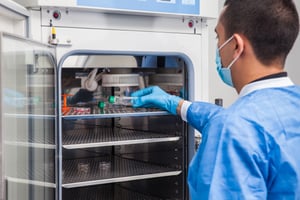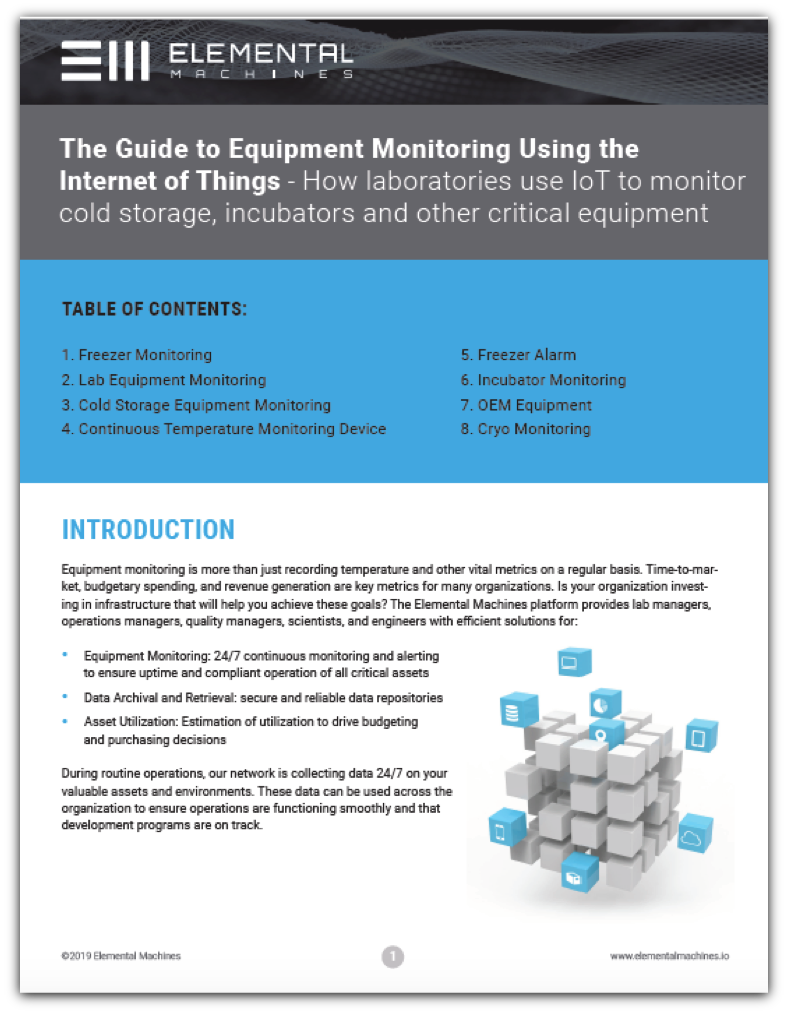Equipment Monitoring: Incubator Monitoring
Measure CO2, temperature, and other critical parameters on your incubators
 INTRODUCTION
INTRODUCTION
The potential behind new biological therapies and stem cell research is fueling an uptick in biological research. Many of these studies require growing specialized cells, such as immortalized and stem cells. Growing these high value cells requires special care, from the raw materials to the process equipment, such as CO2 incubators. There are several incubator parameters that scientists assign and monitor to ensure proper cell growth and proliferation:
Common settings and usage
|
Parameter |
Common settings and usage |
|
Temperature |
Most incubators are set to a temperature of 37 degrees C |
|
Humidity |
Most incubators are set to about 95% relative humidity |
|
CO2 concentration |
Most incubators are set to about 5% CO2 concentration |
|
O2 Concentration |
Most incubators are set to about 20% O2 concentration |
|
Shaker speeds |
The function of a shaker is to distribute nutrients to the cells within the incubator. Shaker speeds may vary based on incubator model and application. |
Note: These conditions are general guidelines and may vary depending on the types of cells and your specific application.
CURRENT INCUBATOR MONITORING:
Many CO2 incubators already have built-in monitoring functions that measure temperature, humidity, CO2 and O2 concentrations, and shakers speeds. When incubator conditions deviate from user setpoints, audible alarms are triggered to alert laboratory staff that incubator conditions must be checked. Some incubators also have built-in data loggers capable of recording environmental parameters for approximately 72 hours.
While current incubator models offer some utility in monitoring environmental parameters, these solutions still fall short of monitoring and alerting staff of out-of-spec conditions. For example, while audible alarms are useful when staff is on-site, this solution fails to solicit corrective action if an alarm is triggered overnight or during weekend hours when staff is less likely to be around. In this case, staff may only become aware of an out-of-spec incubator hours or possibly days after the issue occurred. Another shortcoming of built-in monitoring functions is that they fail to capture out-of-spec incubator conditions caused by power outages. After all, inclement weather, such as snow storms or hurricanes, can lead to power outages that interrupt cellular incubation cycles and thus impede research studies. Lastly, a third major shortcoming of built-in monitoring systems is that they may not allow for data export of the environmental conditions during a cellular incubation cycle. These data records can be quite useful for troubleshooting as well as record keeping for compliance with GXP guidelines.
INCUBATOR MONITORING THROUGH IOT:
New technologies, such as the Internet of Things (IoT), offer more robust incubator monitoring solutions to built- monitoring functions. There are two IoT options available for incubator monitoring.
The first option is an Element-A, a cloud-connected sensor placed inside an incubator to monitor temperature, humidity, light, and air pressure. Oftentimes, this solution is sufficient when a protocol does not contain strict requirements for gas concentrations or when the shaker feature is not in use. Data collected from Element-A is continuously streamed onto the Elemental Machines Cloud for secure storage. Element-A may be used to monitor environmental parameters in any incubator make and model.
The second option is an Element-D data collection device that is connected to an incubator’s data port to collect operational setpoints and actual operational conditions. Parameters that can be monitored via Element-D are: temperature, humidity, CO2 concentration, O2 concentration, and shaker speeds. (Note: Not all parameters may be available on all incubator models.) Similar to Element-A, the data collected by Element-D is continuously streamed to the Elemental Machines Cloud for secure storage.
Users of the Elemental Machines platform can configure customized alerts for each Element-A and/or Element-D on their dashboard. These alerts are triggered when incubator conditions are out of specified range. Users can choose to receive alerts via email and/or SMS.
Incubator monitoring through IoT offers many advantages over traditional built-in incubator monitoring functions. The primary advantage is that data is no longer localized to a specific incubator. Data is available remotely to users for real-time monitoring. Thus, users can respond promptly to alerts even when off-site. Next, IoT offers a broader coverage of failure modes. For example, traditional built-in incubator monitoring functions will fail to alarm in the event of an power outage. However, with connection and power alerts built into IoT devices, users are quickly notified about power outages at the site. Furthermore, battery-powered Element-A sensors, coupled with a battery-powered gateway tablet, can still send environmental data from incubators even when the incubator is powered off. This allows users to track environmental drift within the incubator, which can be used to assess whether the samples in the incubator may be compromised.
Setting up an IoT monitoring for your incubators is a simple, straightforward process. The Elemental Machines platform is designed to be a plug and play product. Just connect the Element-D to your incubator data output or place the Element-A inside the incubator. Data automatically streams to the Elemental Insights Dashboard.
“We are excited about Element-D and have deployed numerous devices on our incubators to track and record CO2 levels. Deployment was straightforward and all of the information is readily available to us on their cloud-based network. We are able to use this data to help simplify asset management, data collection and improve scientific best practices.”
Lyndsey Rissin, Senior Manager, Lab Operations

